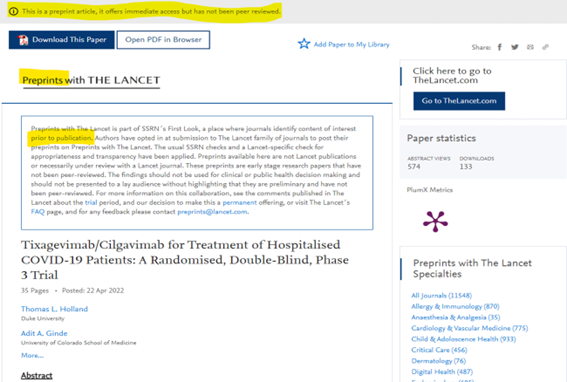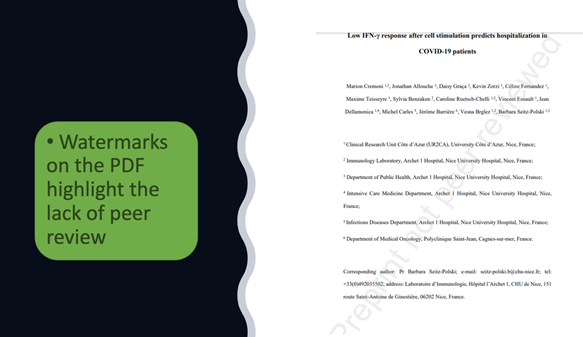MODERATOR:
David S Riley
Editor, The Permanente Journal
Portland, Oregon
@swihm_health
SPEAKERS:
Nicolle Pfeiffer
Chief Product Officer, Center for Open Science
Charlottesvile, Virginia
@nicipfeif
Jessica Polka
Executive Director, ASAPbio
San Francisco, California
@jessicapolka
Clare Stone
Medical Content Editor, SSRN
Oxford, England
@Garvvdogg
REPORTER:
Sarah Frances Gordon
Managing Editor, Psicología Iberoamericana
Universidad Iberoamericana
Mexico City, Mexico
@SF_Gordon
A preprint is scientific information, usually a full manuscript, posted to a preprint server under author control, whereas a journal article is peer reviewed and published under journal control. Preprints are not peer reviewed. They allow members of the scientific community to share scientific information and comments freely and quickly, which is why preprints were embraced early in the pandemic. However, preprints have a long history that began in the health sciences around 1961 when the National Institutes of Health began to share information through the Information Exchange Groups. In the past several years, in the wake of the popularity of preprints, health science journals have begun establishing relationships with preprint servers. This session focused on the preprint system and how it has evolved into an important part of the publishing process.
The session was moderated by David Riley, a medical doctor, and the editor of the Permanente Journal.1 Riley began the session with his observations on how preprints have gained momentum during the pandemic as the public and health authorities have depended on the accelerated dissemination of research results to inform their decisions on vaccines and treatment for COVID-19. Some of the most popular preprint servers include BioRxiv,2 arXiv,3 PsyArXiv,4 PrePubMed,5 and medRxiv.6 Preprints are a rapidly developing area and have begun to influence many fields of science affecting researchers, scientific journals, and editors.
Nicolle Pfeiffer, the Chief Product Officer at the Center for Open Science, was the first speaker and highlighted the benefits and challenges of preprints. The benefits of preprints include the rapid dissemination of research results to the public and scientific community, increased access to research, and increased collaboration. Additionally, when a preprint is posted on a server, it facilitates faster feedback by a broader community, which can strengthen the quality of the paper when it is finally peer reviewed and published. Challenges that the preprint system may face include lack of peer review, lack of trust, and information overload.
Jessica Polka, the executive director of ASAPbio, presented second and discussed how preprints are an opportunity for people to engage more informally with a manuscript and provide valuable feedback. Polka also voiced her concerns about the preprint system, which include how the dissemination of preprints can lead to misinformation and information overload amongst the public. Other concerns raised include the risks associated with premature media coverage of a preprint, publicly sharing information before peer review, uncertainty about copyright and licensing of preprints, and preprint authors potentially getting scooped by others.
However, despite these challenges, there is still a need for the rapid dissemination of research results and feedback from a broader community. Polka contends that it is important to create incentives for preprint peer review, such as the recognition of preprint reviews by institutions. Publicly reviewing a preprint helps increase the rigor of scientific work because criticisms can be validated by others. It also enables participation from a wider scientific community as the full draft of the manuscript is openly available on the server to researchers across the globe. Public reviews of preprints also help complement the peer-review process and help provide context and expert evaluation of the work. Polka argues that you should go one step further and publish your preprint reviews to document your scientific labor.
Clare Stone, a medical editor at SSRN,7 which is affiliated with Elsevier, presented next and spoke about how preprints have evolved in the medical field. For example, at The Lancet,8 authors can opt-in at the submission stage to post their manuscripts on the SSRN preprint server (Figure 1).

Stone emphasizes how preprints impact health policies in real time and help save lives. As noted by one of the SSRN authors, “Everyday matters in the preprint medical world.” However, Stone also discussed the potential risks of preprints and opined that researchers have a responsibility to their community to ensure that what they post on preprint servers is accurate and does not cause harm. It is also vital that preprint servers differentiate between a preprint and a published article that has been peer reviewed. Preprint servers often have warnings that the manuscript has not been peer reviewed and provide watermarks on the manuscript to help prevent confusion among readers (Figure 2).

The session highlighted how the preprint system has taken on a life of its own and has been especially valuable during the COVID-19 pandemic. Horby9 writes in an opinion piece in Nature Medicine that he “cannot envisage a future without such rapid dissemination of new evidence”9,p.1 He concludes that given the important role preprints now play, the medical community and policymakers must use their critical thinking skills and scientific methods to ensure they make sensible decisions, regardless of whether a manuscript is peer reviewed or not.9 This sentiment was echoed through the voices of Riley, Pfeiffer, Polka, and Stone during the session, as they solidified the argument for preprints in science.
References and Links
- https://www.thepermanentejournal.org/
- https://www.biorxiv.org/
- https://arxiv.org/
- https://psyarxiv.com/
- https://www.prepubmed.org/
- https://www.medrxiv.org/
- https://www.ssrn.com/
- https://www.thelancet.com/
- Horby, P. (2022). Why preprints are good for patients. Nat Med. 2022;28:1109. https://doi.org/10.1038/s41591-022-01812-4.
